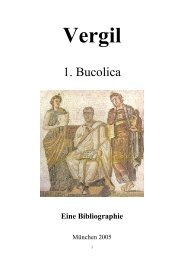Create successful ePaper yourself
Turn your PDF publications into a flip-book with our unique Google optimized e-Paper software.
– (1975/6): “Cernere erat: The Shield of Aeneas”, PVS 15, 1-6 = Robertson (1988), 215-23<br />
= S. J. Harrison (1990b), 295-304.<br />
– (1979): “Herculis clava. Virgil and His Models”, Acta philol. Aeneipont. 4, 77-9.<br />
– (1987): The Bough and the Gate. Jackson Knight Memorial Lecture (Exeter) [D. Fowler,<br />
G&R 36, 1989, 103-4] = S. J. Harrison (1990b), 224-38.<br />
– (1989): “The <strong>Aeneid</strong> and the Translator”, Vergilius 35, 31-46.<br />
– (1993a): “The Pageant of the Heroes as Panegyric (Virgil, Aen. 6.760-886)”, in Jocelyn, H.<br />
D. (1993; ed.): Tria Lustra (Liverpool), 283-96.<br />
– (1993b): “On Serial Narration and on the Julian Star”, PVS 21, 1-16.<br />
– (1994a): “In the Wake of Aeneas (<strong>Aeneid</strong> 3.274-88, 3.500-5, 8.200-3)”, G&R 41, 57-61.<br />
– (1994b): “Me, You or Us”, Vergilius 40, 35-6.<br />
– (1998): “The End and the Meaning: <strong>Aeneid</strong> 12.791-842”, in Stahl (1998b), 303-18.<br />
West, Grace Starry (1979): “Vergil’s ‘Helpful’ Sisters: Anna and Juturna in the <strong>Aeneid</strong>”,<br />
Vergilius 25, 10-19 = Lawall (1979), 33-44.<br />
– (1980a): “Caeneus and Dido”, TAPhA 110, 315-24.<br />
– (1980b): “The Significance of Vergil’s Eriphyle (<strong>Aeneid</strong> 6.445-6)”, Vergilius 26, 52-4.<br />
– (1983): “Andromache and Dido”, AJPh 104, 257-67.<br />
– (1985): “Chloreus and Camilla”, Vergilius 31, 22-9.<br />
West, Stephanie (2003): “Crete in the <strong>Aeneid</strong>: Two Intertextual Footnotes”, CQ 53, 302-8.<br />
Westendorp Boerma, R. E. H. (1958): “Vergil’s Debt to Catullus”, AClass 1, 51-63.<br />
Wetmore, Monroe Nichols (1911): Index verborum <strong>Vergilian</strong>us (New Haven, etc.); repr.<br />
Hildesheim/Darmstadt, 1961.<br />
Wheeler, Stephen M. (1993): “Lost Voices: Vergil, <strong>Aeneid</strong> 12.718-19”, CQ 43, 451-4.<br />
Whitfield, John Humphreys (1969): “Virgil Into Dante”, in Dudley (1969), 94-118.<br />
Whitman, Jon (1987): Allegory: The Dynamics of an Ancient and Medieval Technique<br />
(Oxford).<br />
Wifstrand Schiebe, Marianne (1981): Das ideale Dasein bei Tibull und die<br />
Goldzeitkonzeption Vergils. Acta Universitatis Upsaliensis. Studia Latina Upsaliensia 13<br />
(Uppsala).<br />
– (1983): “Der Black-out des Aeneas. Zur Frage der Diskrepanz zwischen zweitem und<br />
drittem Buch der Aeneis”, Eranos 81, 113-16.<br />
– (1986): “The Saturn of the Aeneis – Tradition or Innovation?”, Vergilius 32, 43-60.<br />
– (1997): Vergil und die Tradition von den römischen Urkönigen. Hermes Einzelschriften 76<br />
(Wiesbaden) [I. E. M. Edlund-Berry, BMCRev 97.11.15; M. Fox, JRS 88, 1998, 195; G. K.<br />
Galinsky, Vergilius 44, 1998, 125-8; S. Koster, AAHG 51, 1998, 39-41; J. Poucet,<br />
Latomus 58, 1999, 927-8; H. Heckel, Gymnasium 107, 2000, 255-6; Eibach, HZ 270, 2000,<br />
721-2; C. Martín Puente, Emerita 68, 2000, 204; F. Stok, IJCT 7, 2000/1, 113-4; R.<br />
Granobs, Gnomon 73, 2001, 398-402].<br />
Wigodsky, Michael (1972): Vergil and Early Latin Poetry. Hermes Einzelschriften 24<br />
(Wiesbaden) [V. Buchheit, Gymnasium 82, 1975, 100-4].<br />
– (2004): “Emotions and Immortality in Philodemus On the Gods 3 and the <strong>Aeneid</strong>”, in<br />
Armstrong/Fish/Johnston/Skinner (2004), 211-28.<br />
Wilhelm, Michelle Pach (1987a): “Arrival in Latium: New Loyalties and Preparations”,<br />
AugAge 6, 62-79.<br />
– (1987b): “Venus, Diana, Dido and Camilla in the <strong>Aeneid</strong>”, Vergilius 33, 43-48.<br />
– (1992): “Minerva in the <strong>Aeneid</strong>”, in Wilhelm/Jones (1992), 74-81.<br />
Wilhelm, Robert McKay (1983/4): “The Chariot/Ship. Vehicle of Augustan Ideology”,<br />
AugAge 3, 73-94.<br />
– (1987): “Aeneas and Dido: The Search for a New City”, AugAge 6, 31-61.<br />
– (1988): “Cybele: The Great Mother of Augustan Order”, Vergilius 34, 77-101.<br />
112



